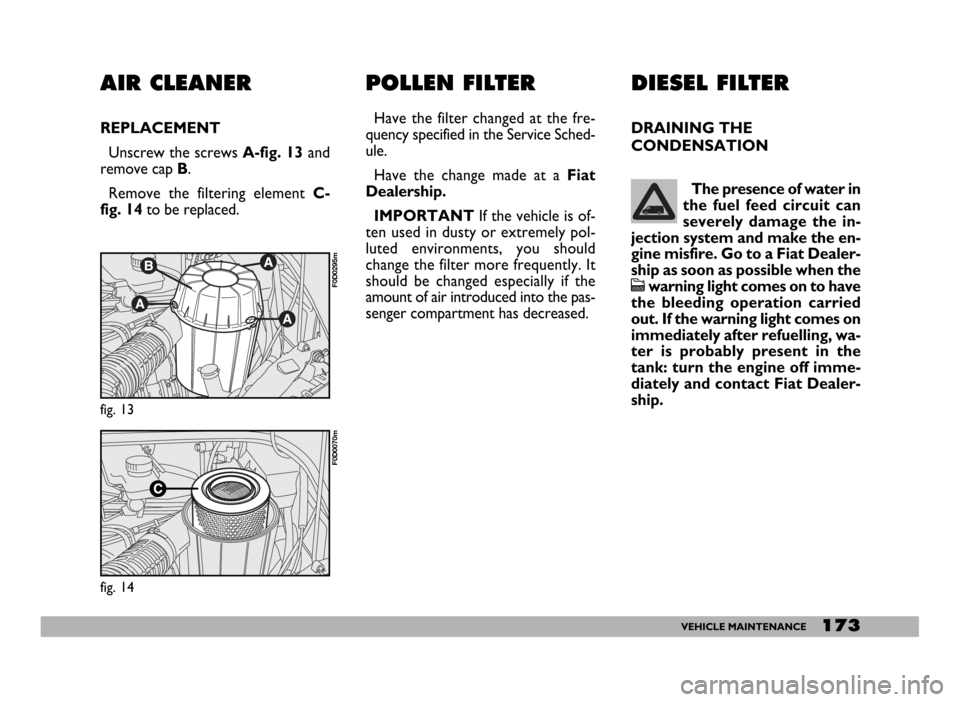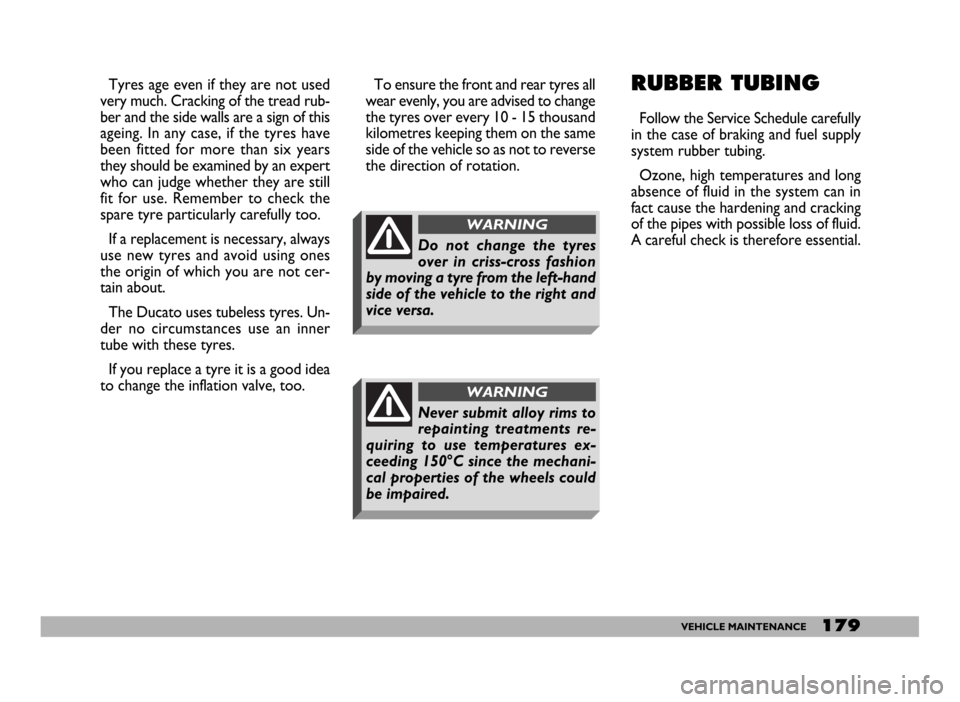2005 FIAT DUCATO 244 Fuel
[x] Cancel search: FuelPage 166 of 258

165VEHICLE MAINTENANCE
ANNUAL
INSPECTION
SCHEDULE
The following annual inspection
schedule is required for vehicles trav-
elling 15,000 Kmapprox. a year. The
schedule includes the following oper-
ations:
– check tyre condition and wear and
adjust pressure, if required (including
spare wheel);
– check operation of lights (head-
lights, direction indicators, hazard
lights, boot light, passenger compart-
ment light, instrument panel lights,
etc.);
– check windscreen wiper/washer
and adjust nozzles;
– check position and wear of wind-
screen/rear window wiper blades;
– check front pad conditions and
wear;
– check for bonnet and boot lock
cleanness, lever cleanness and lubri-
cation;– inspect conditions of: engine, gear-
box, transmission, piping (exhaust, fu-
el feed, brakes), rubber parts (boots,
sleeves, bushings, etc.), brake and fu-
el line hoses;
– check battery charge status;
– check conditions of various control
belts;
– check and top up fluid levels (en-
gine coolant, brakes, windscreen
washer, battery, etc.);
– check and top up engine oil;
– replace pollen filter.
ADDITIONAL
CHECKS
Every 1,000 km or before long
trips, check and top up as necessary:
– engine coolant level
– brake fluid level
– power steering fluid level
– battery electrolyte level
– windscreen washer fluid
– tyre pressure and conditions.
Every 3,000 km or before long
trips, check and top up as necessary:
engine oil
Every 10,000 kmor at cwarning
light coming on (diesel engines only):
bleed water from fuel filter.
You are recommended to use FL
Seleniaproducts designed and pro-
duced for Fiat vehicles (see the “Ca-
pacities” table in the “Technical Spec-
ifications” section).
Page 167 of 258

166VEHICLE MAINTENANCE
IMPORTANT - Pollen filter
If the vehicle is often used in dusty
or extremely polluted environments,
you should change the filter element
more frequently. It should be changed
especially if the amount of air intro-
duced into the passenger compart-
ment has decreased.
IMPORTANT - Diesel filter
Refuelling with diesel fuel not com-
plying with the grade of purity pre-
scribed by European Specification
EN590 might make it necessary to re-
place the filter more frequently than
indicated in the Service Schedule.
IMPORTANT - Battery
The charge in your battery should be
checked, where possible at the start
of the winter, to limit the risk of the
battery electrolyte freezing.
This check should be carried out
more frequently if the vehicle is mainly
used for short trips or if it is fitted
with accessories that permanently
take in electricity even when the igni-
tion key is removed, especially in the
case of after market accessories.You should check the battery fluid
(electrolyte) level more frequently
than shown in the Service Schedule if
the vehicle is used in hot climates or
particularly demanding conditions.
IMPORTANTAs concerns Camp-
ing Car versions, due to high electric
absorption, observe indications rele-
vant to battery contained in para-
graphs "Vehicle storage" (section
"Getting the best out of your vehicle")
and "Battery – Checking the charge"
(section "Vehicle maintenance").
Maintenance of your ve-
hicle should be entrusted
to a Fiat Dealership. For
ordinary routine maintenance
operations which you are able to
carry out yourself, ensure that
you have the necessary tools and
original Fiat spare parts and flu-
ids available. Do not carry out
servicing operations if you have
no experience.IMPORTANT - Engine oil
Change the engine oil more fre-
quently than shown in the Service
Schedule if the vehicle is normally dri-
ven in one of the following particular-
ly severe conditions:
– towing a trailer
– on dusty roads
– short distances (less than 7-8 km)
repeated and with external tempera-
tures below zero.
– frequently idling engines or long
distance low speed driving (e. g. taxis
or door-to-door deliveries) or in case
of a long term inactivity replace engine
oil more frequently than required on
Scheduled Maintenance Plan.
IMPORTANT - Air cleaner
Replace the air cleaner more fre-
quently if the vehicle is used on dusty
roads.
If you are in doubt about how often
the engine oil or the air cleaner should
be changed in relation to how you use
the vehicle, contact a Fiat Dealer-
ship.
Page 174 of 258

173VEHICLE MAINTENANCE
AIR CLEANER
REPLACEMENT
Unscrew the screws A-fig. 13and
remove cap B.
Remove the filtering element C-
fig. 14to be replaced.
fig. 13
F0D0295m
fig. 14
F0D0070m
POLLEN FILTER
Have the filter changed at the fre-
quency specified in the Service Sched-
ule.
Have the change made at a Fiat
Dealership.
IMPORTANTIf the vehicle is of-
ten used in dusty or extremely pol-
luted environments, you should
change the filter more frequently. It
should be changed especially if the
amount of air introduced into the pas-
senger compartment has decreased.
DIESEL FILTER
DRAINING THE
CONDENSATION
The presence of water in
the fuel feed circuit can
severely damage the in-
jection system and make the en-
gine misfire. Go to a Fiat Dealer-
ship as soon as possible when the
cwarning light comes on to have
the bleeding operation carried
out. If the warning light comes on
immediately after refuelling, wa-
ter is probably present in the
tank: turn the engine off imme-
diately and contact Fiat Dealer-
ship.
Page 180 of 258

179VEHICLE MAINTENANCE
Tyres age even if they are not used
very much. Cracking of the tread rub-
ber and the side walls are a sign of this
ageing. In any case, if the tyres have
been fitted for more than six years
they should be examined by an expert
who can judge whether they are still
fit for use. Remember to check the
spare tyre particularly carefully too.
If a replacement is necessary, always
use new tyres and avoid using ones
the origin of which you are not cer-
tain about.
The Ducato uses tubeless tyres. Un-
der no circumstances use an inner
tube with these tyres.
If you replace a tyre it is a good idea
to change the inflation valve, too.To ensure the front and rear tyres all
wear evenly, you are advised to change
the tyres over every 10 - 15 thousand
kilometres keeping them on the same
side of the vehicle so as not to reverse
the direction of rotation.RUBBER TUBING
Follow the Service Schedule carefully
in the case of braking and fuel supply
system rubber tubing.
Ozone, high temperatures and long
absence of fluid in the system can in
fact cause the hardening and cracking
of the pipes with possible loss of fluid.
A careful check is therefore essential.
Do not change the tyres
over in criss-cross fashion
by moving a tyre from the left-hand
side of the vehicle to the right and
vice versa.
WARNING
Never submit alloy rims to
repainting treatments re-
quiring to use temperatures ex-
ceeding 150°C since the mechani-
cal properties of the wheels could
be impaired.
WARNING
Page 215 of 258

214TECHNICAL SPECIFICATIONS
ENGINE
GENERAL FEATURES
Engine code
Cycle
Number and layout of cylinders
Diameter x stroke mm
Total capacity cm3
Compression ratio
kW
Maximum power output EEC HP
corresponding ratio rpm
Nm
Maximum torque EEC kgm
corresponding ratio rpm
Spark plugs
Fuel
2.0
RFL
Otto
4 in line
86x86
1998
9.5 : 1
81
110
5700
168
17.1
3700
RC9YCC
RFC52LS
Unleaded
petrol
95 RON2.0 JTD
RHV
Diesel
4 in line
85x88
1997
17.6 : 1
62
84
4000
192
19.6
1900
–
Diesel for
motor vehicles
(EN590
specifications)2.3 JTD
F1AE0481C
Diesel
4 in line
88x94
2286
19 : 1
81
110
3600
270
27.6
1800
–
Diesel for
motor vehicles
(EN590
specifications)2.8 JTD
8140.43 S
Diesel
4 in line
94.4x100
2800
18 : 1
93.5
127
3600
300
30.6
1800
–
Diesel for
motor vehicles
(EN590
specifications)2.8 JTD
POWER
8140.43 N
Diesel
4 in line
94.4x100
2800
18 : 1
107
146
3600
310
31.6
1500
–
Diesel for
motor vehicles
(EN590
specifications)
Page 216 of 258

215TECHNICAL SPECIFICATIONS
FUEL SUPPLY/IGNITION
Petrol version
Electronic Multipoint sequential
phased integrated electronic injection
and ignition; a single injection system
controls both functions. It processes
both the time the injection lasts (for
fuel metering) and the ignition advance
angle.FUEL SUPPLY
JTD/JTD POWER versions
UNIJET (Common Rail) electronic
control direct injection, turbosuper-
charger with WASTEGATE valve and
intercooler (2.3 JTD, 2.8 JTD and 2.8
JTD POWER versions).SPARK PLUGS
The cleanness and soundness of the
spark plugs are very important for
keeping the engine efficient and pol-
luting emissions down.
The appearance of the spark plug, if
examined by an expert eyes, is a good
way of pinpointing a problem even if it
has nothing to do with the ignition sys-
tem. Therefore, if the engine has prob-
lems, it is important to have the spark
plugs checked at a Fiat Dealership.
The spark plugs must be
changed at the times
specified in the
SERVICE
SCHEDULE
. Only use the type of
plugs indicated: if the heat ratio
is less than required or the life
specified is not guaranteed, prob-
lems can arise.
Modifications or repairs to
the fuel feed system that
are not carried out properly or do
not take the system’s technical
specifications into account can
cause malfunctions leading to the
risk of fire.
WARNING
Page 228 of 258

227TECHNICAL SPECIFICATIONS
VAN WEIGHTS
Weights (kg)
Version 11 (*)
Kerb weight
(including fuel,
spare wheel, tools
and accessories):
Payload including
driver (1):
Maximum admitted
loads (2)
– front axle:
– rear axle:
– total:
Towable weight:
– trailer with brakes
– trailer without brakes
Maximum load on ball coupling
(trailer with brakes)
Maximum load on roof
(1) If special equipment is fitted (tow hitch, etc.), the unladen vehicle weight increases, thus reducing the specified payload.
(2) Loads not to be exceeded. The driver is responsible for arranging the loads so that they comply with these limits.
* The figures given refer to panelled and glazed vans with medium and short wheelbase, both high and low sided.2.0
1695 ÷ 1780
1120 ÷ 1170
1600
1600
2865 ÷ 2900
2000
750
80
1002.0 JTD
1755 ÷ 1840
1060 ÷ 1145
1600
1600
2900
1600
750
80
1002.3 JTD
1825 ÷ 1910
990 ÷ 1075
1600
1600
2900
2000
750
80
1002.8 JTD
1850 ÷ 1935
965 ÷ 1050
1600
1600
2900
2000
750
80
100
Page 229 of 258

228TECHNICAL SPECIFICATIONS
Weights (kg)
Version 15 (*)
Kerb weight
(including fuel,
spare wheel, tools
and accessories):
Payload including driver (1):
Maximum admitted
loads (2)
– front axle:
– rear axle:
– total:
Towable weight:
– trailer with brakes
– trailer without brakes
Maximum load on ball coupling
(trailer with brakes)
Maximum load on roof
(1) If special equipment is fitted (tow hitch, etc.), the unladen vehicle weight increases, thus reducing the specified payload.
(2) Loads not to be exceeded. The driver is responsible for arranging the loads so that they comply with these limits.
* The figures given refer to panelled and glazed vans with long, medium and short wheelbase, both high and low sided.2.0
1695 ÷ 1865
1435 ÷ 1510
1750
1850
3245 ÷ 3300
2000
750
80
1002.0 JTD
1755 ÷ 1840
1435 ÷ 1505
1750
1850
3300
1600
750
80
100
2.3 JTD
1725 ÷ 1995
1305 ÷ 1475
1750
1850
3300
2000
750
80
100
2.8 JTD
2.8 JTD POWER
1850 ÷ 2020
1280 ÷ 1450
1750
1850
3300
2000
750
80
100